Key Takeaways:
- This radio galaxy, named Alcyoneus, stretches at least 16 million light-years across, making it the largest structure of galactic origin ever found.
- Alcyoneus’ size pushes the boundaries of our understanding of how radio galaxies grow and function.
- Studying Alcyoneus could lead to a better grasp of how supermassive black holes interact with their surroundings and how these giant radio galaxies evolve.
- Astronomers used the LOFAR network of radio telescopes to pick up faint radio emissions from Alcyoneus’ massive jets.
- Alcyoneus’ faint nature made it invisible before, highlighting the need for improved detection methods to uncover hidden giants in the cosmos.
From 3 billion light-years away, a group headed by Ph.D. candidate Martijn Oei of Leiden Observatory in the Netherlands found a radio galaxy that is at least 16 million light-years long. According to the press release, it’s the biggest structure of galactic origin that has been discovered, and it challenges some long-held theories regarding radio galaxies.
Above all, it draws attention to how little is known about these massive cosmic structures and the processes that propel their growth. This discovery may lead to a deeper comprehension of massive radio galaxies.

Supermassive Black Holes in Radio Galaxies
Supermassive black holes, which are found in radio galaxies, release energy when matter falls into them in the form of two radio jets that originate from opposite sides of the galactic nucleus. Giant radio galaxies, which are made up of a host galaxy and enormous jets and lobes that shoot out of its center, are yet another enormous mystery in a universe full of mysteries.
According to Science Alert, these jets and lobes are accelerating electrons and producing radio emissions by interacting with the intergalactic medium and acting as a synchrotron. Astronomers refer to a black hole as “active” when it is accreting material from a giant disk around it; these jets are thought to have been created by the supermassive black holes inside them.
This phenomenon is also observed in other galaxies, including the Milky Way. However, the reasons behind this phenomenon and their absolute growth into enormous sizes in certain galaxies remain a mystery to scientists. Scientists could investigate cosmic objects such as these radio galaxies to gain a deeper understanding of the universe.
However, occasionally just a small amount of the material in the area of the accretion disk swirling into an active black hole is directed toward the poles, where it is propelled into space at huge speeds in the form of jets of ionized plasma, which eventually expand into massive radio-emitting lobes.
In the study “The discovery of a radio galaxy of at least 5 Mpc” that was published in the journal Astronomy and Astrophysics, Oei clarified that the host of the largest giant radio galaxies is probably going to have properties that are beneficial to the growth of giant radio galaxies. Similarly, if large-scale environments were favorable to hosting giant radio galaxies, then they would have hosted the largest radio galaxies.
How They Detected Alcyoneus Radio Galaxy
Alcyoneus, a massive progeny of Gaia, has been named by astronomers as the largest galaxy ever discovered. According to Space.com, they discovered Alcyoneus using data from the Low-Frequency Array (LOFAR) network of radio telescopes located throughout Europe. Two enormous plasma plumes were observed by researchers to be released from the galaxy’s center supermassive black hole.
The diameter of these two plasma plumes exceeds 100 Milky Ways, making them the largest known structure of galactic origin. The components of a star are among the material that these jet streams blast into space. These plumes heat up, dissolve into plasma, and glow in radio light that aided LOFAR in detecting them as they move nearly at the speed of light.
The Alcyoneus was previously undetectable to astronomers due to its relatively faint plumes. But as they reprocessed existing images, they found subtle patterns that alerted them to the massive galaxy.


